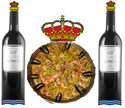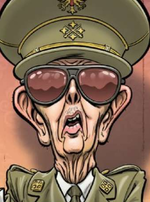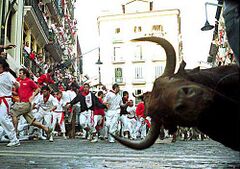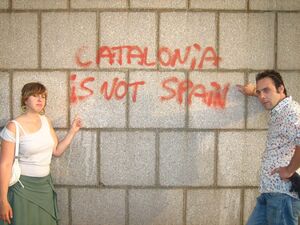Spain
España The Holy Hispanic Illegal Immigrant's Kingdom of España Spain | |||||
|---|---|---|---|---|---|
| |||||
| Motto: "¿Por qué no te callas?" | |||||
| Anthem: “Yo soy español, español, español” | |||||
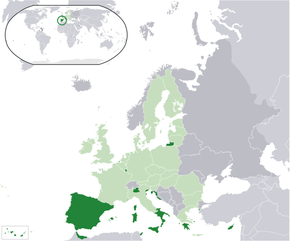 | |||||
| Capital | Madrid | ||||
| Largest city | Madrid | ||||
| Official language(s) | Spanish, Catalan, Galician, Euskera (Basque), English | ||||
| Government | Constitutional Monarchy | ||||
| National hero(es) | Don Quijote and Sancho Panza (tie) | ||||
| Currency | Euros, Ham, Cheese, Wine, Mullets | ||||
| Religion | Association football and dancing the Macarena to inspire goals | ||||
Spain is a country located in South-Western Europe, bordered by France to the north, Portugal to the west, and Catalonia, Galicia and the Basque country on the inside. It is the thirteenth richest country in the world by GDP, and the world's leader in unemployment.
History[edit]
Spain was a peaceful place until civilized man appeared. The Carthaginians under Hannibal were hanging out in Spain until 210 B.C. when the Roman Empire showed up and kicked them out.
The Romans held control of things until these bad asses called the Visigoths showed up.
In the 8th Century all that came to an end when Muslims (who liked to be called Moors) quickly slaughtered the Visigoths. The Moors set about Islamicizing Spain by covering it with minarets, tranquil gardens and fragrant orange groves. However their constant beautification of the country left them little time for military preparation.
For the next seven hundred years warfare between Christians and Muslims occurred as Christians pushed everybody who didn't think like them out the door.
The Moors left a huge influence in Spain, from the wailing vocals of Flamenco, which sound uncannily like an Arab being shaken until the dates fall out of his pockets, to the architecture.
Perhaps the most notable example of the struggle between the two creeds is the one time "Mosque-Cathedral" of Córdoba. As the name suggests, the incredible building, begun in the year 600, originally served as a mosque, but was later converted by Christian forces, and became the world's only example of a cathedral inside a mosque.
The renovations continued into the 21st century, and at the last time of checking, the building was a broom cupboard inside a toilet inside an office inside a fascist interrogation centre inside a basketball court inside a cathedral inside a mosque.
Unification of Castile and Aragon[edit]
Spain was not always united, however. After banding together to kick the Muslims out, nobody could decide who was the cooler Spain. On the one hand, you had Castile, the larger presence on the Iberian peninsula, which always managed to get borderline-stillborn retards onto the throne. On the other hand, you had Aragon, whose purpose was basically to exist in the Mediterranean and beat up pirates to steal their treasure. Historians still debate whether it's more formal to call them Castile and Aragon, or Spain 1 and Spain 2.
In the 15th century, a miracle happened. Castile managed to get a non-lobotomite on the throne, a woman named Isabella. In a similar fashion to a girl joining a Counter Strike match, everyone around wanted to unite with her. Ferdinand of Aragon was successful, and through marriage, the two realms were united, and Spain never had a civil war again.[citation needed]
The Hotness of Imperial Spain[edit]
The red-haired Joanna the Mad (the self-styled “Her Royal Hotness” HRH), helped unify several lonely bachelors and create the Kingdom of Spain that we know today. Joanna liked the rough stuff more than ruling the country, and feigned schizophrenia so her relatives would keep her locked up.
Phillip the II followed up this act with hitting the low countries hard. So hard in fact that they named the Philippines after his exploits. Several thousand G.I.’s would follow his example in WWII.
While Conquistadors were busy conquering the peoples of Latin and South America, the Spanish Inquisition started their first season run on state television.
After several friendly but unsuccessful conversations with everyone around about who should take care of the Atlantic, America and well, half of the world, Spaniards decided enough was enough and went to have a siesta. Napoleon invaded, was kicked out by the outraged people, surprised to be suddenly awakened without advice and those awfully nice British chaps, and the Spanish Civil War caused everyone a headache.
World Wars[edit]
Spain missed out on the fun of the great World War conflicts and concentration camps as they were busy with their own trench warfare to do list. During this period Spaniards argued over tyrannical system that could best control and terrorize each other into line. Communism proved rather soft core and Nationalism seemed not quite patriotic enough. In the end everyone settled for a happy lowest common denominator in the form of Fascism under the good sport Franco. During this time Spain built a few railroads and taught regional minorities how to communicate and write with sophistication omitting the barbarous letters "k" and "w". As the years went by there was a general feeling in the country side that not enough people were summarily executed and too few citizens mysteriously disappeared. Thus Spain entered the modern world of democracy kicking and screaming with terror at the burden of personal choice and frightening equality.
Language[edit]
Spanish is the second most widely spoken language, with almost 400m natives spitting out words like machine guns. There are two genders, five ways to translate "you", over 5000 irregular conjugations, and more than 211 obscenities that begin with the phrase, "I shit on".
The language spread with the Spanish Empire, and the locals decided they preferred a language that was written by ink rather than holy sacrificed blood.
Today it is also one of the most studied languages around the world. Producers of Spanish language text books and dictionaries are obliged to use yellow, red, or orange on the front cover.
Despite Spanish's success outside of Spain, it has mixed popularity in the country, with some Spaniards preferring to speak Catalan, Valencian, Basque, Galician, Occitan or English. Occasionally, the name of the language is even called into question. Around 390m native speakers might call it español, but at least 10m insist on calling it castellano, just to make clear that it is not "the Spanish language" but rather one of several Spanish languages.
Even among Spaniards who are happy to speak Spanish Castellano, there is considerable confusion. Unlike other Hispanic countries, people in Spain often lisp, but cannot decide when they should do it. Traditionally, a "th" sound should be made for a "z" or a "c" when it comes before and "e" or an "i". This is maintained in Don Quixote's old stomping ground, Castilla-La Mancha, but many variants can be found, see below.
| la casa (the house) | la caza (the hunt) | la caca (the poo) | la cerveza (the beer) | |
|---|---|---|---|---|
| Quixote folk | "la kasa" | "la katha" | "la kaka" | "la therbetha" |
| Andalucians | "la katha" | "la katha" | "la kaka" | "la therbetha" |
| Seville-ians | "tha thatha" | "tha thatha" | "tha thatha" | "tha thethetha" |
| Obtuse Catalans and Basques | "la kasa" | "la kasa" | "la kaka" | "la servesa" |
And just in case you thought that the capital might be a bastion of correct Spanish, think again. For some reason, Madrileños are the only Spanish speakers in the world who even make the last "d" in a word into a "th".
| Madrid | |
|---|---|
| Madrid | "Madrith" |
| Everywhere else | "Madrid" |
In Spain, when you have had enough of languages, you start to eat. So, onto food.
Cuisine[edit]
Tapas[edit]
Tapas are small portions of food which are often served with drinks. The name comes from an abbreviation of the expression, "esta comida es mía, no te pases", meaning "this food is mine, don't eat it all". The culture developed during the famine at the beginning of the 20th century, when many Spaniards were forced to eat a single olive for breakfast, sniff anchovy paste for lunch, and share a potato for dinner.
One variety of tapas are pinchos. These are tapas held together by toothpicks which should be kept, tallied and paid for when settling. Note that tourists are the only patrons who don't bury, burn, swallow, hide or obliterate the toothpicks.
Paella[edit]
Paella, despite being one of Spain's most famous dish, is arguably its most mispronounced. Speakers should pronounce both l's, producing a three syllable word along the lines of "pie-el-la". Failure to sound both l's in authentic fashion often causes amusement among natives, who never tire of hearing misinformed tourists asking for "pie-ey-ya".
Tortilla[edit]
Spanish tortilla is exactly the same as its Mexican namesake. As a joke, Spanish restaurateurs will often give tourists la patata de verguenza (literally, "the potato of shame"), a kind of potato pie. The expected response to this is for the tourist to click his fingers in the air and shout "arriba" until the tacos and hot sauce are brought out.
Salad[edit]
Salad was prohibited during the Civil War because it was associated with Catalan Communists and now, although technically legal, is difficult to find in Spanish restaurants. Adventurous diners may chance their luck by asking for ensalada rusa (Russian salad) in hushed tones. In some cases, restaurateurs will accordingly serve a sad portion of lettuce, dry tomato, and not much else.
Status of Tuna[edit]
Despite the lack of salad, one delicious vegetable you will find in abundance in Spain is tuna. This vegetable, often served in small chunks, is usually the primary ingredient in Spanish vegetarian dishes.
Drinks[edit]
Sangría[edit]
Many countries make shit wine, but only Spain had a good idea about what to do with it: mix it with lemonade, and liberally add whatever spirits you have in your cupboard which you cannot describe without using the words "fucking strong".
Many sangría recipes actually insist that the wine used be cheap. However, bear in mind that in Spain it is possible to buy a bottle of red wine for less than a bottle of milk.
If faced with an irretrievably, cheaper-than-milk bad bottle of wine, a true Spaniard will decline the possibility of making sangría and toss in some Fanta (for Tinto de Verano), Coca Cola (for Kalimotxo) or basically any soft drink that will take the head off the wine.
While traditionally sangría was used as a last resort, it is now widely recognised as a useful way to get a foreign blonde girl completely hammered and into bed.
Milk[edit]
For reasons best known to themselves, the Spanish prefer UHT milk. This beverage exists in a purgatorial state, in which it is never actually good, but nor does it seem to go bad.
Soft drinks[edit]
Similarly, in a country where the temperature rarely drops below 70 degrees, locals have developed the odd custom of keeping all soft drinks away from refrigerated areas in the supermarket. They also make a habit of walking around shirtless, wearing very little below the waist and following to moan about the absence of a cold beer.
Café con leche[edit]
Café con leche (coffee with milk) is among the most relaxing drinks to have in the world. Spaniards usually have one in the Plaza Mayor in Madrid.
Sports[edit]
In Spanish, the closest translation of "sport" is "deporte" which literally means "unsporting". This is reflected in Spain's love for uneven contests.
Uneven contest between man and bull[edit]
Bullfighting, or Tauromaquia, is one of the most distinctive sporting traditions in Spain. Students of Spanish may well notice the word's resemblance to maquillaje, or makeup. This is no coincidence. The sport began as an attempt to "beautify the beast", and young toreros would risk their lives in the attempt to leave the local bulls looking as feminine as possible, covered with blusher and eye liner.
This led to much gouging and death. Spaniards quickly realised that bulls were intelligent enough to learn from their encounters with humans, and that a bull who had undergone one session of makeup was likely to be a deadly adversary. The sport accordingly developed in such a way that professional toreros were only expected to make up bulls who had never encountered a man before.
The deliberate targeting of inexperienced bulls changed the nature of the sport, but men continued to be killed. A second major development in the sport was initiated by Isidro R. Ramirez, known as El Cid. Ramirez, who had lost four of his brothers to a gorgeous bull called Maria Luisa, began to kill the bulls after making them look nice. The variation on the traditional practice caught on, so much so that today the murdering of the bull has become the main facet of tauromaquia, with its feminine origins reflected only in the girly costumes of the toreros and the pretty little banderillas (literally, "gay sticks") that are pushed into the bull's shoulders before it is killed.
Uneven contest between 2 football teams and the rest[edit]
There are many football teams in Spain, but all but two of them are made up of amateurs, homosexuals, beggars, alcoholics, and in two notable cases, animals. The two exceptions, Real Madrid and Barcelona, win everything and take all the money. The average Spaniard spends 42 hours a week speaking about or watching football, despite the fact that the storyline is exactly the same every year.
The only game that Spanish people like more than football is Spanish football. Spanish football is similar to regular football, with the same rules and a similar "sprit of the game", except they have far superior players and team dynamics. Whenever Spaniards are tired of watching Barcelona and Real Madrid beat every team in the UEFA league, they will watch DVDs of the most recent World Cup or European Championship and watch the mesmerising ballet of hairy Mediterranean legs smacking a ball into a poorly guarded goal.
Uneven contest between Spanish footballers and other men[edit]
Top players in Spain are known for their dedication to facial hygiene and hair creams and an always unending streak of getting lucky every night. One of the handsomest men to walk on Spanish soil (Piqué) is currently dating Shakira, while other footballers date German models and American superstars. While this may occur in other places, the magnitude of the "beauty and the beast" factor among ugly Spanish futbolistas and smoking hot chicks is rarely surpassed.
Flag and colours[edit]
The flag of Spain is made of Red and Gold colours and in some renditions a Bull. The Gold colour refers to the Gold that Spain borrowed from the native population of the Americas for safe keeping. The Bull refers to the animal which is seen as an object of controversey for those outside of the Iberian peninsula. Spaniards like to spend lazy afternoons watching professionals in an arena give bulls full Swedish massages and either a pedicure or manicure depending on the mood of the audience. The colour red symbolizes many aspects of Spanish culture. The red sun never set on the Spanish empire (while it was an empire), Spanish people usually have blood that is red and traffic lights also flash red when cars are technically expected to stop.
Regions of Spain that hate Spain[edit]
Catalonia[edit]
Catalonia's capital, Barcelona (Bar-zuh-łon-nuh) is the first city you need to check out.
Almost everyone from this region of Spain believes they are part of their own nation called Catalonia. Feel free to remind them that Barcelona is Europe, and you will get drunk and urinate in the street just as freely here, as you would in Paris.
You probably missed the 1992 Olympics because you were in grade school, but don’t worry all those fancy hotels they built are still there waiting to overcharge you for a toothbrush, shampoo, and late night entertainment.
Basque Country[edit]
The Basques are a mysterious people, possibly descended from the survivors of Atlantis who insist on having no red or yellow in their regional flag, and decline to speak a language remotely related to Latin.
In their spare time, Basques enjoy playing sports which involve ripping the heads off dead geese. No, really.
The Basque country earned considerable notoriety in the 1970s and 1980s as the home of ETTA, a terrorist organization obsessed with Etta James. Basque separatists even today insisting on singing the words of "I'd Rather Go Blind" when the Spanish national anthem is played.
This region is also home to the village of Pamplona, famous for its Fiesta de San Fermín and the annual running of the bulls. "Running" is Spanish for "goading, chasing and torturing".
Galicia[edit]
Galicia, historically the land of Scots and Irish, is now where Spanish King Philipp 666 maintains the Spanish equivalent of Area 51. The most famous Galician is Charlie Sheen, who imposed discipline on the Galician Guard using his own drug empire and whores. In the Galician capital is the crypt where the Spanish Inquisition keeps the Necronomicon.
Spain today[edit]
Spain today is a marvelous place to live, as long as you restrict your ambitions to working somewhere or other and renting a room in an apartment. Due to the level of paperwork and bureaucracy, inhabitants are not recommended to a) buy a house, b) start a business, c) get married, or d) apply for planning permission to renovate anything. But the weather really is lovely.
See also[edit]
| La Madre Maria: | Spain – Portugal – Andorra – Mexico – Puerto Rico | ||
| Departments (Regions): | Catalonia | ||
| Cities: | Madrid - Barcelona - Lyon - Strasbourg - Versailles - Orly | ||
| Brave Spaniards: | Christopher Colombus | ||
| Cuisine: | Cigars - Octopus - Calamari - Champagne - Spanish Rice | ||
| Conquerors: | Roman Empire - England - Portugal -United Kingdom - France - Russia - Germany - Austria-Hungary - Italy - USA - Islam - Mexico |
| ||||||||||||||

